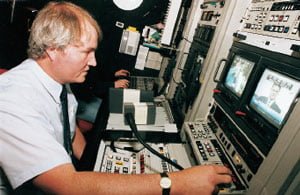
Internal communications occur between various members and parts of an organisation and, usually, there are several different ways of delivery. Communication is a two-way process through which ideas, opinions and information are passed. When we first think of internal communications we might identify simple information tools such as memos, notices or e-mails, which transmit facts, figures and instructions, usually down the management structure.
For communications to be effective, there are many different channels, each of which should have a clear purpose and should always seek to engage individual employees in the life of the organisation. Good communication does not simply pass information from one place to another – it involves people in the life of the business.
The following is a riddle common to Buddhist, Muslim and Jewish religions: ‘Is there a sound in the forest if a tree crashes down and no one is around to hear it?’ The correct answer is probably ‘no’, on the grounds that there is no sound unless someone perceives the sound waves. This simple riddle helps to make the point that in communication, emphasis should be on the needs of the recipient rather than the sender.
Management theory shows that organisations have simply communicated ‘downwards’ for too long, without taking the needs of the listener into account. Modern theorists argue that communication should focus on what individuals can contribute to the organisation in a way which engages them in key issues. “Communication in an organisation is not a means of organisation. It is a mode of organisation.”
The merger and conversion of the Halifax
This case study focuses on Halifax’s decision to invest in a business television (BTV) system. Although a familiar name on the high street, Halifax’s size and complexity is not so well known. In fact, it is a complex organisation with many different parts. As well as its branch network, it has hundreds of estate agency offices, several head office complexes, a life assurance arm and numerous other parts. When the decision to ‘buy’ business television was taken, this complex organisation was about to embark upon a period of unprecedented change. The management team realised that its internal communication, which at the time was heavily reliant on paper, needed a significant boost.
Interestingly, the BTV decision was made before the decision to merge with Leeds Permanent Building Society and convert to a public limited company, but the system was not yet operational when the plans were leaked to the press in November 1994. Most employees heard about this major step from the morning papers and news bulletins rather than directly from their own managers. How different it would have been if the organisation had had its own television network working that day!
Business Television

Satellite-based television networks for individual businesses are now affordable due to technological advances. Business television programmes originate from a television studio and are then fed to a satellite. The signal is sent back to earth to satellite dishes on individual buildings and displayed on a monitor, in a similar way to domestic television. To prevent unauthorised viewing, signals are scrambled or encrypted. Halifax’s programmes are normally ‘one-way’ but can be interactive with live ‘phone-in’ debates.
The great benefit of business television for Halifax is its ability to help staff improve their understanding and awareness of business issues by providing:
- immediacy – broadcasts are timed to deliver information as it becomes available
- explanation – company ‘experts’ can explain decisions or events to all staff simultaneously
- increased impact – television, as everyone knows, is a very powerful medium
- interaction – staff can access senior managers during live question-and-answer broadcasts
- selectivity – specific groups can be sent tailor-made messages.
Business television is not a new concept. It originally found favour among the large dispersed companies of North America. Pioneers in the field included the electronics giant Hewlett-Packard and the brokerage house Merrill Lynch. Business television provides the ability to communicate directly without the information becoming diluted as it flows down the management chain. It is well known that the spoken word is much more effective than print. Rockwell International, which also uses business television, argue that it binds together a large company, creating a culture which makes staff feel closer to each other. For staff, instant feedback can be sought and received, making the individual feel more involved in the organisation, rather than the recipient of just another memo.
Halifax Mission
Halifax’s mission is to become the UK’s leading provider of personal financial services. To support this mission, senior management identified various activities in which Halifax had to excel. Halifax Television (HTV) makes a vital contribution to the achievement of these goals. As a result, HTV is not seen simply as ‘nice to have but something which plays a part in business success.
Communication management
Business television is a very versatile medium. The most common uses are:
- Senior management can explain the thinking behind important policy matters so staff understand not just what is changing, but also why.
- Day-to-day business communication provides staff with a better understanding of operational issues and the environment in which they work.
- Training can be delivered, either through programmes that employees watch and study or through interactive programmes where “students” can speak live to experts in the studio.
- Customised broadcasts can focus on the needs of specific groups.
Research carried out before Halifax’s pilot broadcast in July 1995, revealed the need to make the programmes concise, relevant and job-related. Staff wanted to be better informed and to hear directly from the decision-makers. They did not want television to cover out-of-hours activities involving staff. The objectives of HTV were established on the basis of five driving forces:
- Business need – to help Halifax deliver its business objectives.
- Audience need – to keep staff informed, giving them news in honest, straightforward programmes.
- The medium itself – to maintain high standards of production.
- Halifax communications policy and values – to adhere to the key principles, for example, honesty.
- Currency – to be alive to the current focus of talk and speculation.
Introducing business television

Starting in April 1995, four months before the merger between the Halifax and Leeds Permanent Building Society, 1850 sites were surveyed and equipment was installed. An editorial team was appointed and a live studio was built in Halifax. The decision to proceed with business television involved an initial investment of around £5 million and an annual production budget of over £1 million. HTV is able to produce programmes at around about 50p per head and is Europe’s largest business television network.
HTV’s audience comprises every member of the Group’s staff i.e. 37,000 people spread over 1,700 locations, and in the Head Office sites in Halifax, Leeds and Bristol. HTV has become essential viewing for all staff at every level in the Halifax Group. In branches, the broadcasts are watched live by teams of staff with their managers and then discussed afterwards. In Head Offices, TV monitors are suspended from the ceiling above open-plan areas, allowing staff to remain at their desks, or to gather around the sets.
Halifax Television News, or HTN, was originally a fortnightly fifteen-minute bulletin, with interviews and longer reports about the Halifax Group – the branches, estate agency, financial services etc. The style was similar to the Nine O’clock News or News At Ten. After more than a year of broadcasts, it was re-launched as a ten-minute news programme supported by ‘HTN Extras for each of the Group’s businesses.
A second programme, created specifically for the branch network, was launched in January 1996. Interact is an informal programme on new products and marketing activities aimed at helping branch staff better understand the products they are selling (e.g. the different types of mortgages) and how to put across their best features to customers.
Activate, the third strand of Halifax Television, was launched in May 1996 and concentrates on training. It has been used to test the use of interactive keypads as a potential solution to the growing requirement for training staff in many different locations. The idea is that all the employees watching the live broadcast can ‘talk’ to the trainer in the studio, either by pressing keys or by using a microphone built into their keypad.
Internal communications
Programmes for HTV are researched, written, produced and edited by an in-house editorial and production team, supported by freelance directors, presenters and crews. HTV has become a key part of the internal communications structure at Halifax and works closely alongside printed information, such as bulletins and staff magazines.
Television is used to ‘break’ news and to increase staff awareness of developments before they read the detail in print. These details are usually circulated after transmission. On the occasions where Halifax has needed to make major announcements to staff, HTV has played a key role. For example, when the organisation needed to introduce new Terms and Conditions, the communications drive started with a broadcast in which the Personnel Director explained the thinking behind the package and its key elements, such as new hours of work.
Evaluation and results
Before the launch of Halifax Television, two external communication agencies were used to research staff perceptions and expectations of business television. A company called Imagination was appointed to guide the HTV team in preparing for the first broadcast on 2nd August 1995 and to contribute to the development of the three strands of programmes for the first year.
Telephone surveys are carried out after each broadcast and feedback from the surveys is used to guide the editorial team as to what subjects they should be covering and how they should be covered.
The second tier of quantitative telephone research was carried out in October 1995, with follow-ups in January and April 1996. Samples averaged 500 staff with a representative spread of grades and locations.
Feedback revealed
October 1995
- Branch staff were more likely to watch HTN than Head Office staff.
- Branch staff were more likely to discuss content and were more positive
- The programme length was about right.
- HTN was rated positive overall (96% agreed it was professional, 80% agreed it kept their interest, 75% agreed it was honest).
January 1996
- HTN continued to be taken more seriously in branches than Head Office.
- The staff continue to perceive HTN as professional.
- The content was becoming increasingly relevant.
- 20% distrusted the honesty of programmes.
April 1996
- More staff agreed that they tried not to miss HTV broadcasts.
- A higher proportion of staff were watching the video later.
- There was an increase to over 80% discussing broadcasts afterwards.
- Improvement in credibility.
- The high scores for relevance, professionalism and honesty from staff and the increasing demand for programme-making from management, supported the HTV team’s perception that programmes were meeting and exceeding its objectives.
Feedback

During the summer of 1996, concerns were voiced in the branch network about the loss of valuable discussion and training time between 9 am and 9.30 am on Wednesday mornings. The broadcasts and discussions were occupying much of this valuable half-hour slot when everybody in each branch was assembled. The HTV team was aware that some branch managers were overcoming this problem by simply recording HTV transmissions for staff to watch later. This would dilute the impact of live transmissions.
The re-launch involved shortening the fortnightly news programme, HTN and creating targeted editions for the different parts of the Halifax Group, such as branches, estate agencies and financial services businesses. The response to the new format was measured with a telephone survey of 38 locations. The response was positive with comments like ‘More snappy, punchy,’ ‘more to the point – much better,’ and ‘It gave us what we needed to know.’
When a larger sample, of more than 500 respondents, was interviewed in October and November 1996, the findings were that 70% of the audience thought the programme was better and found the shorter broadcasts more relevant and easier to watch. Moreover, research shows that Halifax staff are now equally likely to expect important policy changes to be communicated to them by HTV as by their manager. Additionally, 70% agree they know more about overall business performance as a result of broadcasts.
Launched the day after the largest-ever building society merger, HTV has since kept staff informed about the major programme of change following this event. Recent employee tracking research highlights the positive attitudes of staff to the new medium. There is little doubt that business television has become a powerful tool for internal communication.

Halifax has recently gone through a complex period of change and development. The merger of two large building societies represented a major internal communications challenge which tested the new medium to the full. Since then, Halifax has converted from being a building society to a plc – a massively complex operation. Again, TV played a big part, keeping staff fully in the picture about progress.
Business television has added value to Halifax’s employee communication strategy by helping to create a better-informed workforce. The annual output exceeds 50 programmes and is well received by the audience.
